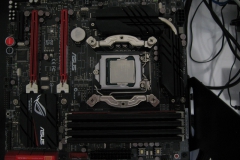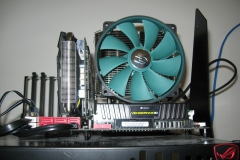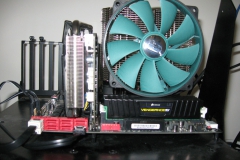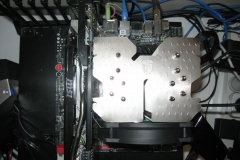We tested the Gamer Storm Lucifer on our ASUS ROG test bench with the specifications listed below. I’d like to reiterate that the ASUS Maximus VI Gene is a great board and the more I work with it, the more I like it. We always re-baseline the fan profile in the FanXpert 2 software and run PWM mode in the ‘standard’ ASUS preset. The MSI GTX760 HAWK is basically silent and the perfect choice when testing as we want as little noise as possible coming from the system so that we can isolate the sound from the CPU cooler itself.
We recorded the delta temperatures for the results – the difference between the reported CPU temperature and the ambient room temperature. In order to record a valid result, the ambient room temperature has to remain the same from the start of the test to the end of the test and must be between 18 and 24 degrees when starting. If the CPU hits 70 degrees over ambient, the test is considered a fail because that delta temperature places the CPU in the 90’s.
To create a consistent loading on the CPU for each run, we ran Prime95 for 30 minutes after a 30 minute idle period. The maximum temperatures across all 4 cores were recorded and an average generated for the results. This is a synthetic load and the closest activity we have seen that comes close to the test is video encoding. Although many games are CPU intensive, none have punished our CPU in the same way as the Prime95 test so you could consider this a worst case scenario.
ASUS Maximus VI Gene Test Bench
| CPU | i5-4670K |
| CPU Cooler | Various |
| Memory | 16GB Corsair Vengeance Low Profile – Black (4x4GB) |
| Case | Lian Li Pitstop T60 |
| Hard Drive | Seagate Barracuda 2TB & Samsung EVO 250GB SSD |
| Power Supply | Corsair HX850 |
| Graphics Cards | MSI GTX760 HAWK |
| Audio | Logitech G430 Gaming Headset |
| Network | Direct connection to the cable modem & Shared Gigabit connection via Netgear WNDR3700 |
| Optical | Samsung SATA2 BluRay drive |
| OS | Windows 8.1 |
Delta Temperature Results
Please note that these are all Delta temperatures where the recorded temperature is the difference between the CPU and the recorded ambient room temperature which was a typically about 20 degrees. So a delta temperature of 35 degrees translates to a real world temperature of about 55 degrees.
“Stock” Intel i5-4670K Test Results

Passive cooling delivered a toasty but acceptable result – in fact better than the stock Intel cooler but silent. I can’t stress enough how this will vary from build to build depending on the case ventilation and position of the case fans in relation to the heat sink, as well as any cables, fan grills or other obstructions. It works and we proved it but I’d be hesitant to recommend it for a high end CPU. The fan hit maximum RPM in both the 12v and the PWM runs which explains the close results. The variance is interesting but we noted the rpm on the PWM run fluctuated a little at the top end – this might have made the difference in the above test.
Overclocked Intel i5-4670K Test Results

In the overclock test, we nailed the vcore to 1.29v and saw the Luficer nipping at the heels of the premium coolers. In this scenario, the constistent speed of 12v seemed to yield a better result than the ever so slightly variable PWM profile.
Gamer Storm “Lucifer Only” Test Results

Idle Delta Temperatures
The idle temperatures are all within a typical margin of error. Measuring idle temps can be finicky due to minor fluctuation among the ‘idle’ processes. Typically we expect delta temperatures around the 8 degrees mark as a standard and the Lucifer in all fan modes except passive gave us between 7 and 9 degrees above ambient and on par with all other coolers we have tested to date.
Load Delta Temperatures
The Lucifer is able to keep our toasty Haswell i5-4670K cool at stock settings and when overclocked. Interestingly, with our CPU running on stock settings, the Lucifer in PWM mode performed a couple of degrees better than when running at 12v but then the result was reversed in the overclock test. I considered that the main difference between 12v and PWM was that at the PWM mode had slight variations in speed due to the polling of the core temperatures and the slight load variation over the 30 minute test. The 12v test ran the fan at the same RPM with almost no variation for the whole test maxing the fan out at about 1350RPM.
The Noctua coolers have the Lucifer covered in terms of performance with the older NH-D14 beating it by almost 4 degrees in our overclock test and the slim line NH-U14S also edging it out by a similar margin a well. The tower heatsink of the Lucifer is about twice as deep as the Noctua NH-U14S and has a similar footprint to the dual tower NH-D14 but with only 1 140mm fan and fin stack. Keep in mind that whilst more effective in our testing, the Noctua coolers are also about $30 more expensive than the Gamer Storm Lucifer.
Adding a second fan (we had a Deep Cool GF140 for this purpose) gave an improvement of around 2 degrees with an increased noise profile. It’s great that you get another set of clips with the Lucifer but I probably wouldn’t bother with a second fan unless you are really needing that extra cooling for an overclock.
It is also worth noting that the load testing of Prime95 is a worst case scenario – even when playing CPU intensive games for hours, we don’t see anywhere near the same temperatures or load on the coolers in normal usage. The tests do show the capability of the coolers in a consistent way making for a balanced comparison.
Acoustic results
In PWM mode, we don’t expect to see as much of a thermal difference between the Lucifer and the rest of the pack because the standard ASUS FanXpert 2 profile has a thermal target. What we look for here is how hard the fan has to work to keep the temperature under 75 degrees and how much noise it makes.
At full speed, the Deep Cool 140mm fan makes more noise than the Noctua A15 on the NH-U14S. I’d call it loud but not obscene and in general use/gaming, the fan didn’t go much over 800rpm. What I did notice however was the change in pitch as the fan speed was adjusted by the PWM profile – this was more noticeable when the fan speed went anywhere above about 900 rpm. If I was using this permanently, I’d just tweak the fan profile by smoothing out the curve and speed up/down durations. The specifications list the fan speed as 700±200~1400±10%RPM. The highest we saw was 1340RPM and the lowest was just under 600RPM and to be fair to the Lucifer, this could have been influenced by our motherboard controller. In any case, the numbers were within the specification tolerance.








